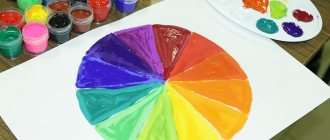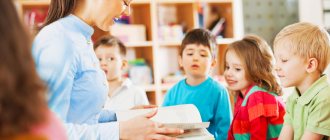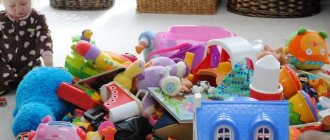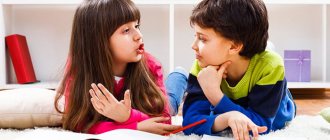Neuropsychological games and exercises in working with preschool children
Antonova Tatyana Konstantinovna
Neuropsychological games and exercises in working with preschool children
Abstract: The work is devoted to the use of neuropsychological knowledge and skills in classes with preschool children in order to reduce the level of perinatal pathology. The compiled set of activities for children in this category helps to activate interhemispheric interaction, which forms the child’s resistance to stress in school. When using neuropsychological games and exercises in classes, children improve memory, self-control of behavior, increase concentration, develop spatial orientation, and increase self-confidence.
Keywords: psychological health, neuropsychological exercises , preschoolers .
An urgent problem in our country is ensuring the mental and psychological health of the younger generation. In the term “mental health”
concepts such as
“human psychology”
and
“health psychology”
.
“Mental health”
as a set of normally functioning mental mechanisms and processes.
The term “psychological health”
, according to I. V. Dubrovina [2, p.
28], characterizes the personality as a whole and evaluates the manifestations of the human spirit. For preschoolers , the criterion of psychological health is the harmony of the child and society.
Many modern experts believe that without psychological health it is impossible to talk about the self-sufficiency of an individual. In recent years, fewer and fewer children with the first health group have been born. There is an increase in the incidence of various neuropsychic disorders, the prevalence of pathologies of pregnancy and childbirth, somatic diseases and other pathological conditions in childhood , leading to mental development disorders, is increasing. Perinatal pathology of the central nervous system, even in the case of a favorable outcome, has long-term consequences and negatively affects the mental development and social adaptation of the child. Unfortunately, in most cases, children with this type of pathology disappear from the attention of specialists after the first year of life. To avoid this, it is necessary to use an integrated approach to this problem [3, p. 5]. Only the joint activities of specialists can improve the health and harmonize the development of the younger generation. Neuropsychology of childhood is one of the disciplines that develops scientific and applied aspects of health-saving technologies for children.
The psychological health of a preschool child is characterized by the development of mental processes, mental performance , the predominance of positive emotions over negative ones, adequate self-esteem, the level of maturity of the processes of excitation and inhibition, self-confidence and self-confidence.
In kindergarten, every specialist uses health-saving technologies in their work . In the classes of a teacher-psychologist, physical exercises, breathing exercises, finger exercises, eye exercises, psycho-gymnastics, play therapy, and sand therapy are used. When working with different age categories of children, it is worth noting that a number of pupils experience difficulties concentrating and switching attention, a slight decrease in auditory-verbal memory, motor impairment, difficulties in drawing, cutting, designing, mild speech deviations and peculiarities of the emotional sphere.
For the successful learning and development of a child at school, one of the main conditions is the full development of interhemispheric interaction preschool Neuropsychological exercises develop the corpus callosum, increase stress resistance, synchronize the work of the hemispheres , improve mental activity, help improve memory and attention, and facilitate the process of reading and writing [1, p. 189]. When preparing children for school, it is necessary to pay great attention to the development of the corpus callosum (interhemispheric connections)
. After all, a violation of the corpus callosum distorts cognitive activity. The main development of interhemispheric connections is formed in girls up to seven years old, in boys up to eight to eight and a half years old.
We have compiled a set of neuropsychological exercises (V. S. Kolganova, E. V. Pivovarova, I. I. Pravednikova)
for classes with
children of the preparatory group [3, p. 12]. This complex includes breathing exercises , oculomotor exercises , stretching, and motor repertoire
exercises Group classes are held once a week. The article presents exercises that can be included in various types of classes as physical exercises.
Breathing exercises . Such exercises are aimed at restoring normal breathing at rest, as well as in combination with various movements, which contributes to increased oxygen supply to all organs and tissues of the body, optimization of muscle tone, reduction of excitability, and improvement of the child’s general condition.
"Balloon"
.
I. p. The child is standing (or sitting)
.
Hands are on the stomach. At the adult’s command “inhale,”
the child takes a deep breath through his nose
(mouth closed)
and inflates his stomach like a balloon, then, at the command
“exhale,”
the child exhales noisily through his mouth, simultaneously with the exhalation he draws in his stomach.
"Fist-finger"
.
I. p. The child is sitting or standing. During the adult’s command “inhale,”
the child inhales through the nose (mouth closed, while simultaneously turning his thumbs up. During the adult’s command
“exhale,”
the child exhales through a wide open mouth, while simultaneously turning his thumbs down. Breathing is slow and deep. Move only hands.
"Fist-palm"
.
I.p. The child stands with his feet shoulder-width apart. Head straight, eyes looking forward. The arms are extended to the sides, the palm of one hand “looks down”
, the fingers look to the side, the palm of the other hand is clenched into a fist.
During the adult’s command to “inhale,”
the child simultaneously unclenches the fist of one hand, the palm
“looks”
at the floor, and the palm of the other hand clenches into a fist.
During the adult’s command to “exhale,”
the child simultaneously changes the position of his fist and palm. Breathe, quickly changing the position of your fist and palm alternately.
Oculomotor exercises . By the age of three, a child should be able to evaluate space by 1800 vertically and 1800 horizontally and track this without turning his head. Very often, children have narrowed fields of visual perception. If the scope of visual perception is narrowed, the child sees only what is in front of him. He notices the rest only by turning his head and the whole body. And it is not surprising that this child can be quite traumatic and gets tired very quickly.
“Following the subject”
. I. p. The child is standing (sitting, head motionless, mouth closed.
Level 1. Straight arms.
1) The child holds a pen with a bright cap (small toy, candy)
above the bridge of the nose, first with the right straight hand and leads it to the right, lingers for 1-2 seconds at the end point, leads it back to the middle. The head does not move, the child's eyes follow the tip of the pen.
2) The child transfers the pen to his left hand. He holds the pen above the bridge of his nose with his left straight hand and moves it to the left, holds it for 1-2 seconds at the end point and leads it back to the middle. The head does not move, the child's eyes follow the tip of the pen.
3) The child takes the handle above the bridge of the nose with two straight hands and leads it up, holds it for 1-2 seconds at the end point and leads it back to the middle. The head does not move, the child's eyes follow the tip of the pen.
4) The child holds the handle above the bridge of the nose with two straight hands and moves it down. Then he holds the handle for 1-2 seconds at the end point and leads back to the middle. The head does not move, the child's eyes follow the tip of the pen.
5) The child holds the handle over the bridge of the nose with two straight lines. Leads the pen to the bridge of the nose (while moving to the bridge of the nose and back, the arms do not bend, holds the pen for 1-2 seconds near the bridge of the nose and leads back to the middle. The head does not move, the child’s eyes follow the tip of the pen.
During this exercise, are straight and do not bend at the elbows (during movement to the bridge of the nose and back, the arms are bent)
.
Level 2. The same exercise is performed with arms bent at the elbows.
The exercise is performed no more than two times at each level.
Motor repertoire exercises In the process of performing exercises of the motor repertoire, a gradual development of the space of one’s own body and the space around one’s body occurs. Practicing concepts such as “top-bottom”
,
“front-behind”
,
“right-left”
, is a good prevention of writing, reading and counting disorders in older
preschoolers .
"Mirror"
. The adult stands opposite the child. The adult reminds the child that if you stand facing each other, right and left change.
1) At the direction of an adult, the child must first show himself, then the adult’s left arm, right shoulder, left knee, etc.
2) The adult shows the movements, the child must repeat them. Moreover, if an adult performs a movement with his right hand, then the child must also perform the movement with his right hand. For example, an adult touches his left ear with his left hand, a child should also touch his left ear with his left hand.
3) The adult and the child change roles: the child commands and checks the correctness of the task. The adult completes the task. To make the exercise more effective , an adult is recommended to make mistakes sometimes; the child should notice this.
"Robot in search of treasure"
.
The child must portray a robot that accurately and correctly carries out the adult’s commands. The adult explains and shows the child what an extension step is. The child takes a step with one foot, and then places the other foot next to the first. Then the adult asks and works with the child: the number of steps; type of steps (large, medium, small)
;
direction of movement (forward, backward, right, left, turn right, turn left)
; Which foot should you take a step on?
1) An adult says: “You will follow my commands. If I say "step forward"
, you will take a step forward.
If I say “two steps to the left
,” you take two steps to the left.
If I say “big steps”
, you take big steps, etc.”
2) If the child has mastered this exercise , the adult can give two, three or four commands at once, for example: “step forward; then turn right; four small steps forward; three big steps back, starting with the right foot, etc.” And if you put a surprise at the end point, the exercise will become even more enjoyable.
exercises are suggested to develop attention :
"Damn the leaf"
.
At the same time, with both hands, the child crumples two pieces of paper and then smoothes them out. The exercise is performed on weight . The faster the child does this, the better. The smaller the size of the pieces of paper, the more difficult it is to perform the exercise .
"Castle"
.
The child clasps his hands and twists his thumbs around each other, first in one direction, then in the other. The exercise is performed as quickly as possible.
The child should look intently at the thumbs. Using these exercises in classes with children (especially older preschool age )
contributes to the activation of interhemispheric interaction, which forms the child’s resistance to stress in school.
To summarize the above, we can draw the following conclusion: when using neuropsychological games and exercises in classes, children improve memory, self-control of behavior, increase concentration, develop spatial orientations, and increase self-confidence. And this, in turn, is one of the main criteria for the psychological health of preschool children .
Bibliography:
1. Wiesel, T. G. Fundamentals of neuropsychology : a textbook for university students / T. G. Wiesel. – M.: V. Sekachev, 2022. – 264 p., color insert 12 p.
2. Dubrovina, I.V. et al. Psychology: Textbook for students. avg. ped. establishments/I. V. Dubrovina, E. E. Danilova, A. M. Prikhozhan; edited by I. V. Dubrovina. – M.: Publishing House
, 1999. – 464 p.
3. Kolganova, V.S. Neuropsychological classes with children : At 2 hours Part 1./Valentina Kolganova, Elena Pivovarova, Sergey Kolganov, Irina Friedrich - M.: AIRIS-press, 2022.- 416 pp.: ill.
What kind of exercises are these?
Neuropsychology is a relatively young field that combines knowledge of psychology, neuroscience and psychophysiology. The subject of neuropsychology is the study of connections between the functioning of the brain and ongoing mental processes. We mainly study processes that occur with disturbances due to diseases or injuries.
Accordingly, neuropsychological gymnastics are special sets of exercises that help correct certain psychophysiological disorders.
Such complexes are indicated for children with the following problems:
- birth injuries;
- decreased or increased muscle tone;
- frequent illnesses;
- the child did not crawl until he was one year old;
- walked with support on his toes;
- started speaking late;
- has a history of mental retardation, mental retardation, ADHD or similar diagnoses;
- irritable, hot-tempered, conflicted;
- hyperactive (or very slow);
- gets tired quickly, has trouble falling asleep;
- poorly understands the speech of adults addressed to him;
- writes illegibly;
- omits or replaces some letters with others in a letter, or writes them in a mirror image;
- has difficulty mastering school material;
- when reading, he “swallows” endings and thinks out words;
- has difficulty comparing, generalizing, remembering;
- has problems with fine motor skills;
- constantly moves tongue or legs while writing or drawing;
- cannot sit still for 15 minutes;
- absent-minded, inattentive;
- does not finish what he starts;
- distracted, unable to concentrate for long periods of time;
- cannot switch from an incorrect way of performing a given task to the correct one;
- spends a long time doing homework;
- awkward and clumsy.
Not just pedagogy...
Modern teachers are coming to the understanding that pedagogical methods alone cannot solve all of a child’s learning problems.
Of course, psychological characteristics and social environment always have their influence. But beyond this, there are processes that are more deeply related to the development of the brain in the first years of life. Adherents of neuropsychology argue: a child may not feel spelling, for example, due to the fact that he missed the crawling stage in infancy. Child neuropsychology is a very young but rapidly developing science that provides answers to many questions surrounding child behavior and perception. One of the founders of neuropsychology was the Soviet psychologist and neuropathologist Alexander Luria. During World War II, a doctor had to work with head injuries without proper diagnostic tools. He could practically guess what kind of trauma he was dealing with. Various tests came to the rescue. In peacetime, test methods continued to develop, revealing to scientists the secrets of the brain. 20-30 years ago, a branch of science appeared - child neuropsychology.
How does neuropsychology work? Let's imagine the brain in the form of a New Year's garland. We take it out of the box and it turns out that some of the lights don't light up. They have to be tightened and repaired so that the garland shines the way it should. This is what neuropsychologists do. The peculiarity of children's neuropsychology is that the brain is very plastic until the age of 11. At an early stage it is easier to solve problems, but if they are left “as is”, they will only take root and build on one another.








